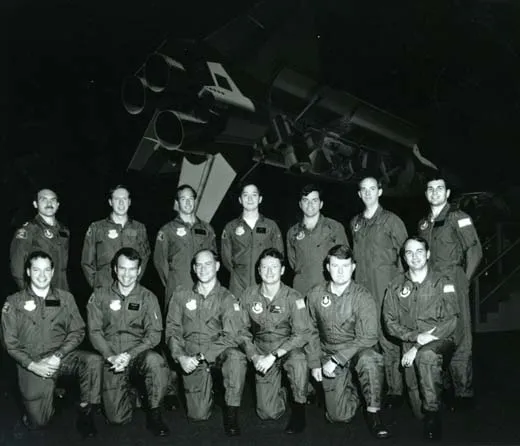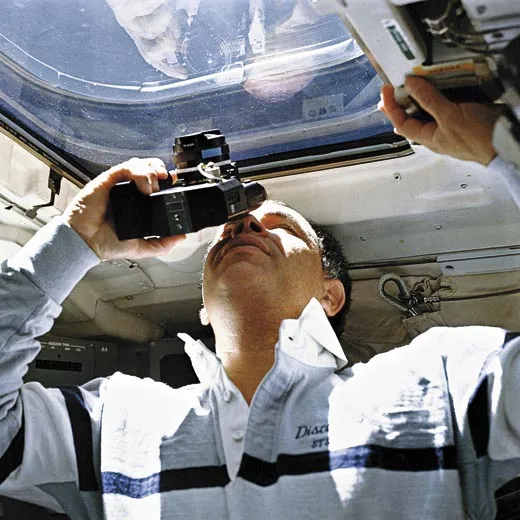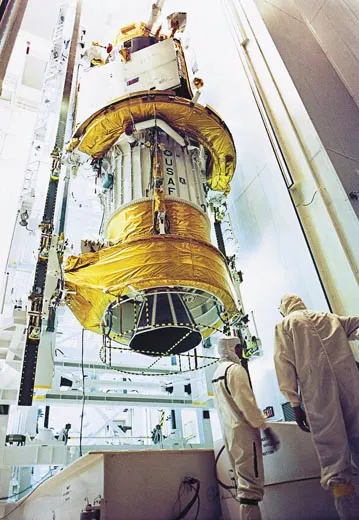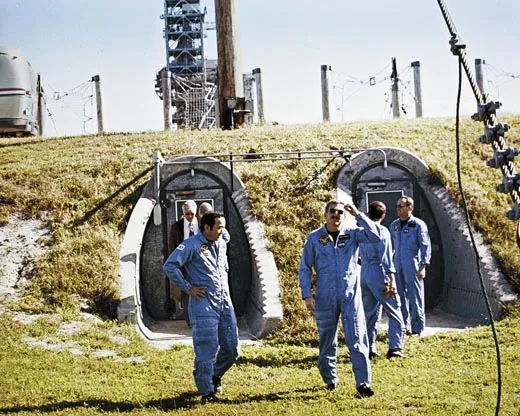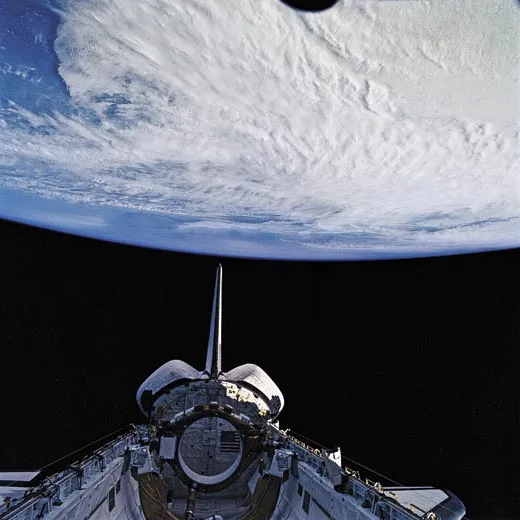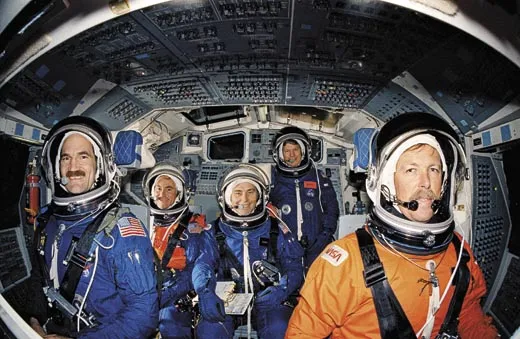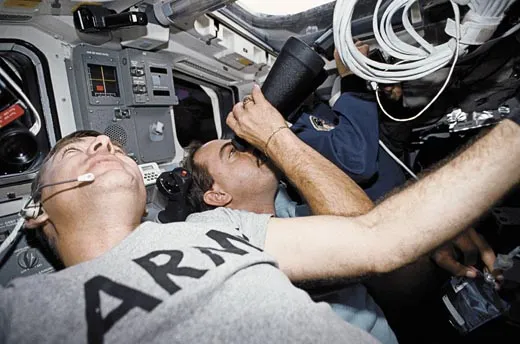The Secret Space Shuttles
The Pentagon also used NASA’s space truck, but was a lot less willing to discuss what went on up there.
/https://tf-cmsv2-smithsonianmag-media.s3.amazonaws.com/filer/ae/38/ae380e13-ebf3-40fc-82dc-13654efa6673/sts028-22-030_orig.jpg)
The giant gold and silver satellite glittered against the black sky as space shuttle Atlantis closed in on it from below. Commander Hoot Gibson and pilot Guy Gardner flew the approach, while mission specialist Mike Mullane, at the other end of the flight deck, readied the shuttle’s robot arm for a capture. Downstairs in the airlock, mission specialists Jerry Ross and Bill Shepherd waited in their spacesuits for Gibson’s order to go outside and attempt a rescue.
The mission of STS-27 had been to deploy the first in a series of new spy satellites that used radar to observe ground targets, in any kind of weather, day or night. But shortly after the astronauts released the spacecraft, called ONYX, from the shuttle’s cargo bay, on December 2, 1988, one of its antenna dishes had failed to open. Without intervention by the crew, the billion-dollar satellite would become a hunk of space junk. As it turned out, they succeeded in grabbing, fixing, and re-releasing ONYX, for which they later received a medal from the U.S. intelligence community.
At least that’s one possible scenario for what happened. The astronauts may just as well have fixed the satellite without a spacewalk by Ross and Shepherd. We don’t know because not a word of the ONYX rescue was reported in newspapers or on television. Why not?
Because STS-27 was—and remains—a secret mission.
Between 1982 and 1992, NASA launched 11 shuttle flights with classified payloads, honoring a deal that dated to 1969, when the National Reconnaissance Office—an organization so secret its name could not be published at the time—requested certain changes to the design of NASA’s new space transportation system. The NRO built and operated large, expensive reconnaissance satellites, and it wanted a bigger shuttle cargo bay than NASA had planned. The spysat agency also wanted the option to fly “once around” polar missions, which demanded more flexibility to maneuver for a landing that could be on either side of the vehicle’s ground track.
“NRO requirements drove the shuttle design,” says Parker Temple, a historian who served on the policy staff of the secretary of the Air Force and later with the NRO’s office within the Central Intelligence Agency. The Air Force signed on to use the shuttle too, and in 1979 started building a launch pad at Vandenberg Air Force Base in northern California for reaching polar orbits. Neither the Air Force nor the NRO was ever comfortable relying exclusively on NASA’s vehicle, however. Delays in shuttle launches only increased their worry; even before the 1986 Challenger accident, they were looking for a way off the shuttle and back onto conventional rockets like the Titan.
The uneasy relationship between the Air Force, NRO, and NASA assumed a human face in 1979, when the military chose its first group of shuttle astronauts. Two years before the shuttle’s first launch, the NRO selected 13 Manned Spaceflight Engineers as potential payload specialists, all but one from the Air Force. The new military astronauts ranged in age from 24 to 36. Most had advanced degrees in engineering; one was a Ph.D. They were experienced in satellite flying and acquisition. And they believed they were the vanguard of the Air Force in space.
Only one of that first group ever made it to orbit.
Paul Sefchek, one of those who didn’t (he retired from the Air Force in 1989 and died in 1997 at the age of 51), told me in an interview years ago that his colleagues were like “old Army scouts who were sort of aimed at NASA by the Air Force and told to find out whatever they could find out. They returned to the fort bleeding and full of wounds.”
One fundamental problem was how the two agencies perceived “payload specialists.” NASA thought of them as outsiders, almost guests—engineers or scientists who tended one particular satellite or experiment, and typically flew just once. The MSEs thought their job was to help bridge the gulf between the military and civilian space agencies.
It didn’t work. Gary Payton, now deputy undersecretary of the Air Force for space, is the only one of the first group of military astronauts to fly; he recalls, “I was naive enough to believe that the payload side would be treated by NASA the same way the Air Force launch people treated us. In the world I came from, payload requirements would drive the time of day you launched, the time of year, everything. In 1980, NASA was still worried about getting the shuttle to fly. So we were not paid much attention to. It was a rude awakening.”
In addition to cultural differences, there were plain old turf battles. According to Dave Vidrine, director of the military astronaut program in the early 1980s, one eager MSE, whom he didn’t want to name for publication, was “coming up with a lot of new projects and carving out his own turf.” On one occasion, NASA astronaut Ellison Onizuka was training underwater at the Johnson Space Center for a spacewalk when the MSE, a qualified scuba diver, decided he needed to measure a piece of equipment. He and another member of the Air Force team in Houston jumped into the training pool and went to work. The NASA test conductor spotted the two unauthorized divers and ordered them out of the pool. A shouting match ensued, and the offending MSE was banned temporarily from the center.
T.K. (Ken) Mattingly, an Apollo-era astronaut who also reached the rank of rear admiral before retiring from the Navy in 1989, commanded the shuttle’s fourth mission, in June 1982, which carried the program’s first classified payload. He describes the relationship between the NASA astronauts and the MSEs in those early days as “sour.”
Nor did the MSEs have much support within the Pentagon. Jeff DeTroye, one of the first 13 military astronauts, was assigned to escort General Lew Allen, Air Force chief of staff, during a visit to Los Angeles for the 20th anniversary of the NRO in 1981. Upon learning of DeTroye’s involvement in the shuttle, Allen was blunt. He had played “a primary role in canceling the Manned Orbiting Laboratory [a proposed military space station of the 1960s], and had he had his way, would have canceled the shuttle,” DeTroye says. Allen made it clear he thought there was no role for man in space, period, according to DeTroye.
Mattingly says, “I sometimes thought the only people in the Air Force really interested in the shuttle were the MSEs.”
Still, the classified payloads had to be launched—not just on the secret flights, but as secondary payloads on NASA-sponsored shuttle flights too. Once the two sides started working together on actual missions, things improved, according to Payton, who was part of the support team for Mattingly’s STS-4 flight. “We found that once the shuttle had flown, there were people inside NASA who were eager to satisfy military requirements,” he remembers. “We saw that the [NASA] folks were pretty damn good!”
On the other hand, the STS-4 payload, identified only as “P82-1,” didn’t impress Mattingly. “It was a rinky-dink collection of minor stuff they wanted to fly,” he recalls. P82-1 turned out to be the Cryonic InfraRed Radiance Instrumentation for Shuttle (CIRRIS) and the Ultraviolet Horizon Scanner (UHS), two sensors designed to test missile detection from space. A cover failed to open, so neither worked.
The Air Force-NRO control center for shuttle missions was located in Sunnyvale, California. While Houston and Columbia conversed frequently, no one had come up with a way to refer to the classified control center over the open channel. Payload communicator DeTroye recalled a last-minute panic about the mere mention of “Sunnyvale.” “What were we supposed to say? ‘Columbia, this is…Saratoga’? I can’t imagine what [Mattingly] would have done if he’d heard that.”
The use of code words occasionally got comical. On the seventh day of the mission, Mattingly and pilot Hank Hartsfield were getting ready to return to Earth and had just stored the classified checklists in Columbia’s safe. Sunnyvale then asked them to perform “Tab Echo.” The astronauts looked at each other; neither could remember what Tab Echo was. They opened the safe, removed the checklist, and began paging through it. Sure enough, there was Tab Echo: “Store checklist.”
A few years later, when NASA astronaut Kathy Thornton was preparing for her classified mission, STS-33, “training schedules were coded,” she recalls. “They would say things like ‘Event 7012.’ You had to open up the safe every morning to find out that Event 7012 was food tasting in another building, and you were already five minutes late.”
After STS-4, an ambitious schedule of military missions loomed, and in 1982 the Air Force recruited 14 more MSEs. But the first fully classified flight, STS-10, got delayed due to problems with the new Air Force-built Inertial Upper Stage, used to boost satellites to their designated orbit. Other military experiments flew on NASA missions in the meantime. On flight STS-41G, launched in October 1984, the crew conducted a satellite refueling test “hatched by some Air Force general,” according to journalist Henry S.F. Cooper Jr. in his 1986 book Before Liftoff. Oceanographer Paul Scully-Power was also on board, observing ship wakes on the surface of the sea for the U.S. Navy.
Meanwhile, the crew of STS-10 (renamed STS-51C and commanded by Mattingly) continued to train, all the while pioneering the security procedures that classified missions mandated. A ready room was set up in the astronaut office, complete with a secure telephone that had a secret number. “If certain people need to get hold of you,” Mattingly was told, “they’ll call.” The phone rang just once: The caller asked if Mattingly was interested in subscribing to MCI long distance service.
Another time, Mattingly and three STS-51C crewmates—Onizuka, Loren Shriver, and Jim Buchli—had to take a trip to Sunnyvale. The astronauts were ordered to disguise their destination by filing a flight plan for Denver, then diverting to the San Francisco Bay area. They landed their T-38s at NASA’s Ames Research Center in Mountain View, rented a “junky old car that could hardly run,” according to Mattingly, and drove to an out-of-the-way motel arranged by their secretary. As they pulled up, Buchli, in the back seat, called a halt. “We made extra stops to make sure we wouldn’t come here directly,” he said. “We didn’t tell our families, we didn’t tell anybody where we are. Look at that motel.” On the marquee was written “Welcome STS-51C Astronauts,” with all four names in big type.
Mattingly’s crew—including MSE payload specialist Payton—finally got off the ground in January 1985. For the first time in NASA history, there was no pre-launch public affairs commentary until nine minutes before liftoff. During the flight, the Air Force lifted the veil of secrecy only to admit that the payload was successfully deployed, and that an Inertial Upper Stage was used.
According to most accounts, STS-51C’s payload was ORION, an eavesdropping satellite for signals intelligence. Parked in geosynchronous orbit, it unfurled a dish almost as wide as a football field is long (hence the need for the shuttle’s large payload bay) to listen in on ground communications and telemetry. No one involved with the mission will comment beyond this recent statement from Payton: “It’s still up there, and still operating.”
The second dedicated military flight was STS-51J, the following October. Karol Bobko commanded the crew of five, and Bill Pailes, a member of the second military astronaut group, was on board as a payload specialist. Even before the launch, outside analysts deduced that Atlantis would release a pair of Defense Satellite Communications System spacecraft in orbit.
When STS-51J landed, the first launch from the new west coast shuttle pad at Vandenberg was just a year away. The mission, STS-62A, was to have been commanded by four-time shuttle astronaut Robert Crippen, with Air Force undersecretary Edward “Pete” Aldridge and MSE Brett Watterson along as payload specialists.
Then came the 1986 Challenger accident. As NASA struggled to return the shuttle to flight, the Air Force and NRO sped up their plans to move payloads back to unmanned rockets. The only satellites that would still be launched on NASA’s shuttle were those that couldn’t be shifted to the Titan IV.
When the military abandoned the shuttle, MSEs like Frank Casserino and Watterson suddenly lost their flights. By 1988—the year NASA returned the shuttle to service—the military astronaut corps had disbanded, its members scattered to new assignments. (Of the 27 officers in the first two MSE groups, five would later become generals.)
The remaining classified flights fell to NASA astronauts. The first post-Challenger military mission was STS-27, whose crew rescued the ONYX satellite. Then came STS-28 in August 1989, which analysts assumed at the time—based on its 57-degree orbit that overflew a large percentage of the Earth—carried another imaging satellite. Years later, the sleuths determined that STS-28 had instead carried a Satellite Data System spacecraft for relaying imagery from NRO spy satellites. (That conclusion was confirmed for me by an Air Force officer familiar with the mission, who upon seeing CBS news footage of the NRO satellites in 1998 said, “It’s strange to work on a secret project for 10 years, then see it on network television.”)
The next classified mission was STS-33, in November 1989. Discovery’s crew was commanded by Fred Gregory, with John Blaha as pilot and three mission specialists: veteran astronaut Story Musgrave, Sonny Carter, and Kathy Thornton. Musgrave and Thornton (who had once worked as a scientist for the Army) were the only civilians ever assigned to secret missions. In orbit over Thanksgiving, the crew of STS-33 was able to conduct its mission with limited public scrutiny. The Air Force admitted only that the astronauts deployed a spacecraft using the Inertial Upper Stage; the payload is believed to have been the second ORION eavesdropping satellite.
The cargo for the next classified flight, STS-36 in February 1990, was harder for ground-based sleuths to figure out. The mission was unusual for its highly inclined orbit—62 degrees, still a shuttle record—which took the crew well above the Arctic Circle and far enough south that they could glimpse the coast of Antarctica. The industry magazine Aviation Week & Space Technology reported the payload’s name as “AFP-731” and its weight as 37,000 pounds. For years it was thought to have been an advanced KH-11 imaging satellite; not long after Atlantis’ return, the Soviet news agency Novosti reported that the satellite had “malfunctioned,” and that large pieces of debris were being tracked prior to reentry.
Wrong, says author Jeffrey Richelson, whose credits include books on the Defense Support Program (DSP) early warning satellites and The Wizards of Langley, a 2001 history of technical innovation at the CIA. In the latter book he claims that STS-36 deployed a stealthy reconnaissance satellite named MISTY. The “debris” had likely been jettisoned shrouds or instrument covers. Stealthy or not, the satellite was eventually spotted by amateur trackers in a roughly 500-mile-altitude orbit at a 65-degree inclination.
The November 1990 flight of STS-38 presented another puzzle for spysat detectives. Its trajectory east of Cape Canaveral initially pointed toward a third ORION eavesdropping satellite, but NRO information released eight years later indicates that it might have been a data relay satellite. Richelson has suggested that in addition, STS-38 carried a small “inspector” satellite designed to get close to other spacecraft in geosynchronous orbit. That scenario is still being debated.
With the launch of STS-39 in April 1991, the Department of Defense began to lift the veil on its shuttle operations. The mission was declassified before launch, and NASA was allowed to reveal that it carried a military-sponsored pallet called AFP-675, a reflight of the payload flown years earlier on Mattingly’s STS-4 mission.
Which is not to say that STS-39 didn’t have secrets. One day, according to a member of the crew, another astronaut, Guy Bluford, “went up on the aft flight deck by himself while the rest of us pretended not to notice.” Bluford launched a small classified satellite, purpose still undisclosed.
The trend toward declassification continued with STS-44 in November 1991. Months before the launch, the Air Force acknowledged that Atlantis would carry the 16th DSP satellite for early warning of missile launches. Also on board were some secondary experiments and Army intelligence specialist Thomas Hennen, who flew in space to observe military targets on the ground, under a program known as Terra Scout.
The following year, the existence of the National Reconnaissance Office was officially revealed, just as the queue of secret shuttle payloads wound down to the end. The last dedicated military mission, STS-53, flew in December 1992, carrying a satellite identified as DOD-1, which Richelson and other analysts surmise was another data relay vehicle.
NASA closed the secure control room at JSC in Houston and the equally secure Firing Room 4 at the Kennedy Space Center. The cadre of Air Force support personnel was dispersed. And that brought to an end the sometimes testy, always mysterious relationship between NASA and the Air Force/NRO, which had figured so prominently in the middle decade of the shuttle’s nearly-30-year history.
In 1993, a person identified publicly only as a “high-ranking intelligence official” traveled from Washington to the Johnson Space Center to meet with all the astronauts who had flown secret shuttles and present them with National Intelligence Achievement Medals. At that time, each astronaut was officially cleared to wear the medal in public and to acknowledge the facts written on the citation. Hoot Gibson, for example, could now disclose that he had “returned to” STS-27’s satellite payload, and that the mission specialist on that flight, Mike Mullane, had used the shuttle’s robot arm. Sixteen years later, those brief citations provide almost the only official details of what happened.
Today, the astronauts remain bound to silence. Says Mattingly, “The accomplishments were first-class. I would give anything if someone would say, ‘Here’s what we did. You should be proud of it.’ ”
As for the Ross-Shepherd spacewalk on STS-27, we still can’t say for certain that it happened. There is another clue, however. On February 14, 2001, astronauts Tom Jones and Robert Curbeam were in the middle of their third spacewalk of space station assembly mission STS-98. NASA public affairs had advertised it beforehand as the 100th American spacewalk. But just as the astronauts were about to say something to mark the event, pilot Mark Polansky radioed them on a private channel to warn them off. According to Jones’ 2006 memoir, Skywalking, “Somebody had done a recount, and discovered that the real 100th EVA [extravehicular activity] had been two days ago on EVA-2.”
How could that happen? Had there been a secret spacewalk that never made it into the official tally?
Maybe someday we’ll all be cleared to know.
Michael Cassutt is a novelist and television writer in Studio City, California.
